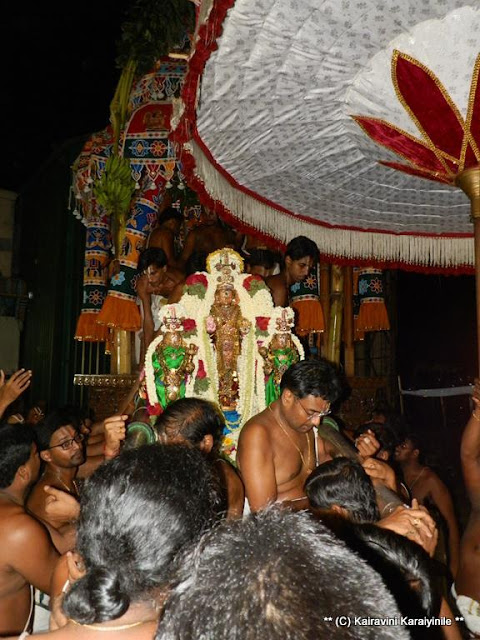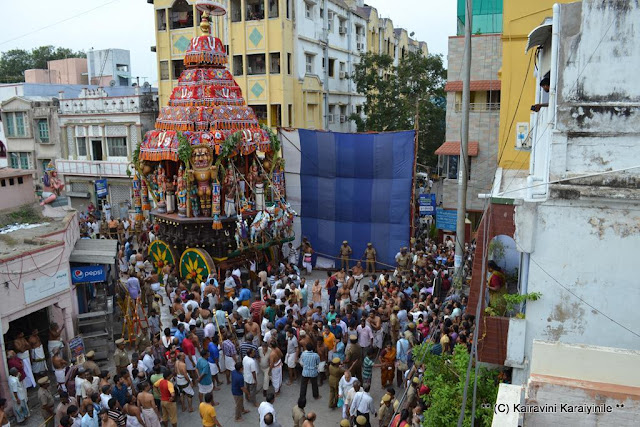We worship Sriman Narayana, as devotees and followers of the Vedic path, we firmly
believe that Lord Krishna descended on
this Universe some 5,000 years ago. His upadesam Srimad Bhagavad Geetha is the
greatest treasure trove, rendered in the midst of Mahabaratha, when He offered
to drive the chariot of Arjuna and earned the sobriquet ‘Sri Parthasarathi’
Today, 21st June 2016 is day 7 of Sri AzhagiyaSingar Aani Brahmothsavam – the grand Thiruther
[chariot]….. one will realise its grandeur that of rolling juggernaut, if one
were to stand near as the 8 or 9 feet wheel rotates by. Thiruther is a
grand occasion of togetherness of people. During Brahmothsavam thousands
throng Temple and have darshan of Perumal in His veethi purappadu ~
significantly, during Thiruther, thousands partake – they pull, go around,
push, offer buttermilk and panakam [jaggery water] to devotees and there is
celebrations on the air, clearly visible.

Could recall that the Thiruther of yore was even bigger ~
in 1980s for a couple of years, there was no Thiruther purappadu as it was
under repair – when made again, in tune with times, it got reduced a bit – also
now it has steel wheels; the earlier one had wooden wheel… it now runs on
concrete cement road. Thiruther, the chariot, is easily the most grandeur and
most attended by bakthas too. Ratha [the chariot] has existed in puranic days,
historic days and more. We have heard of Kings of recent past having had
platoons of horse and horse-driven chariots.
On
screen too, we have seen many – one got enamoured by the scene of Arjuna wading
through the forces in Mahabaratha - even those chariots were quite
attractive. Ratha is not only fleet-footed mode during war, it symbolizes
energy and zeal to move forward. It was on the chariot steered by Lord
Krishna, Geethopadesam occurred to Arjuna, the mighty warrior. The rath
itself according to legend was given by Agni. The battle formation was
unconceivably bigger ~ by some accounts an Akshauhini is described as a
formation consisting of 21870 chariots, 21870 elephants, 65160 cavalry and more
than a lakh of infantry.
Odisha’s
king Narshimhadeva, the first of Eastern Ganga dynasty, decided to make a huge
temple complex consisting of four temples dedicated to the Sun god in 1255 AD.
The site chosen by the architects was in the north-eastern corner of Puri, one
of the four sacred dhams – Konarak, Bhubaneswar. The Konark temple
is designed in the form of the chariot of the Sun god. It has 24 wheels and
seven horses.
It was
a grand festive day at Thiruvallikkeni Divyadesam – the chariot was pulled at
07.00 am and reached back the place by 08.30 am ~ it was heavenly. In the goshti, it was Thirumozhi of
Thirumangai Mannan.
Kaliyan
advises us (saying unto his heart) : the supreme Lord residing in Thiru Oorakam
and Thirukudanthai, is the one who by His bow killed those rakshas of the sena
of Ravana. That Lord of Thirupper
resides in the temple surrounded by fertile fields with chirping water birds,
the One who is worshipped with thousand namas – to Him, the heart should go and
be blessed by the divine.
ஊரான் குடந்தையுத்தமன் ஒருகாலிருகால்சிலைவளைய*
தேராவரக்கர் தேர்வெள்ளம் செற்றான்
வற்றாவருபுனல்சூழ் பேரான்,
பேராயிரமுடையான் பிறங்குசிறை வண்டறைகின்ற*
தாரான், தாராவயல்சூழ்ந்த
சாளக்கிராமமடைநெஞ்சே.
திருவூரகம் திவ்யதேசத்து
எம்பெருமானும், திருகுடந்தையிலே புருஷோத்தமனாகவும் சேவை சாதிக்கும் பெருமான் ஸ்ரீ
ராமாவதாரத்திலே தன்னுடைய வில்லினினாலே,
இராவணனது அரக்கர் சேனையை சிதைத்தான். நெஞ்சே, ஆயிரம் பேர்களாலே
புகழப்படுபவனும், வண்டுகள் ரீங்காரம் இடும், நீர்ப்பறவைகள் நிறைந்திருக்கிற
வயல்களாலே சூழப்பட்ட ஸ்ரீசாளக்ராமத்திலே எழுந்தருளி இருக்கும், அப்பெருமானிடல் சென்று சேர்.
Adiyen
Srinivasadhasan.
















































